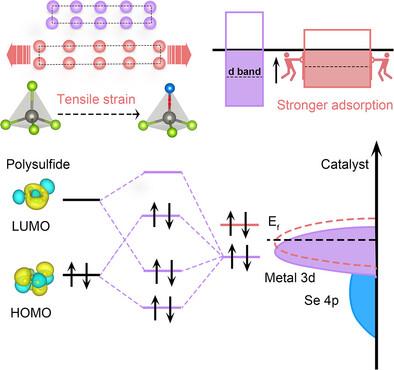通过阴离子控制的张晶格应变活化惰性金属锌催化双功能硫反应
IF 26
1区 材料科学
Q1 CHEMISTRY, PHYSICAL
引用次数: 0
摘要
调节表面应变被认为是提高催化剂双功能活性的有效策略,但尚未在可充电锂硫(Li─S)电池中得到很好的研究。本文开发了一种广义拉伸应变Te - ZnSe催化剂,以创建具有丰富电子态的重分布表面,优化中间结合并激活硫还原反应(SRR)和硫演化反应(SER)。从理论上讲,产生的拉伸应变可以使Zn原子的d带中心上移,减少反键轨道的占用,从而增加多硫化物(LiPSs)对锂多硫化物的吸附能力,减弱S─S键。实验表征和理论分析进一步证实,拉伸应变的Te - ZnSe促进Li─S键断裂,降低锂离子迁移障碍,这在能量上有利于SER。在1℃下循环700次后,拉伸应变ZnSe基Li─S电池仍保持761 mAh g−1的优异可逆容量,且每循环衰减率极低,仅为0.0065%。该研究深入揭示了拉伸应变对提高硫反应双功能活性的作用,为设计高性能Li─S电池催化剂提供了可行的指导。本文章由计算机程序翻译,如有差异,请以英文原文为准。

Activating Inert Metallic Zinc for Bifunctional Sulfur Reaction Catalysis Through Anion‐Controlled Tensile Lattice Strain
Modulating surface strain is recognized as an effective strategy to enhance the bifunctional activity of the catalyst, yet not been well investigated in rechargeable lithium‐sulfur (Li─S) batteries. Herein, a generalized tensile strained Te‐ZnSe catalyst is developed to create a redistributed surface with enriched electronic states that optimize intermediate binding and activate sulfur reduction reaction (SRR) and sulfur evolution reaction (SER). Theoretically, the generated tensile strain can upshift the d‐band center of Zn atoms and decrease the occupancy of anti‐bonding orbitals, thus increasing adsorption capacity and weakening S─S bonds of polysulfides (LiPSs) for lithium polysulfides. Experimental characterization and theoretical analysis further confirm that tensile strained Te‐ZnSe boosts Li─S bond breaking and lowers lithium migration barriers, which is energetically beneficial for SER. The Li─S battery based on ZnSe with tensile strain retains an excellent reversible capacity of 761 mAh g−1 with an ultralow decay rate of 0.0065% per cycle after 700 cycles under 1 C. This research deeply reveals the effect of tensile strain in improving the bifunctional activity of sulfur reaction, offering feasible guidance for designing high‐performance catalysts in Li─S batteries.
求助全文
通过发布文献求助,成功后即可免费获取论文全文。
去求助
来源期刊

Advanced Energy Materials
CHEMISTRY, PHYSICAL-ENERGY & FUELS
CiteScore
41.90
自引率
4.00%
发文量
889
审稿时长
1.4 months
期刊介绍:
Established in 2011, Advanced Energy Materials is an international, interdisciplinary, English-language journal that focuses on materials used in energy harvesting, conversion, and storage. It is regarded as a top-quality journal alongside Advanced Materials, Advanced Functional Materials, and Small.
With a 2022 Impact Factor of 27.8, Advanced Energy Materials is considered a prime source for the best energy-related research. The journal covers a wide range of topics in energy-related research, including organic and inorganic photovoltaics, batteries and supercapacitors, fuel cells, hydrogen generation and storage, thermoelectrics, water splitting and photocatalysis, solar fuels and thermosolar power, magnetocalorics, and piezoelectronics.
The readership of Advanced Energy Materials includes materials scientists, chemists, physicists, and engineers in both academia and industry. The journal is indexed in various databases and collections, such as Advanced Technologies & Aerospace Database, FIZ Karlsruhe, INSPEC (IET), Science Citation Index Expanded, Technology Collection, and Web of Science, among others.
 求助内容:
求助内容: 应助结果提醒方式:
应助结果提醒方式:


